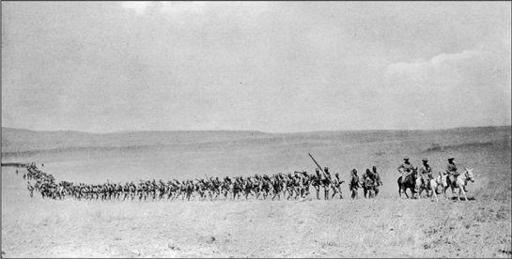The Beauty and the Sorrow (87 page)
Read The Beauty and the Sorrow Online
Authors: Peter Englund

11
.
Sailors gathering ready to demonstrate in Wilhelmshaven, beginning of November 1918:
“[Stumpf] dresses in parade uniform in honour of the day. Then he and the rest of the crew go off to demonstrate. The attitude of the officers suggests that the sailors might well end up being victorious.”
EAST AFRICA
1
.
The war reaches Africa, 1914:
“Roughly 10,000 armed men are looking for each other in an area the size of western Europe but where communications are almost non-existent. The most difficult task is not to defeat the enemy, it is to find him. Any sort of movement demands an army of bearers.”
2
.
German native troops in combat somewhere in East Africa:
“Those in command of the small groups are Germans, clad in all the usual accoutrements of the colonists—light-coloured uniforms, cork tropical helmets and commanding appearance—but the soldiers are all professional native soldiers,
askaris
, who have been given the same training, weapons and trust as white soldiers.”
3
.
The Pangani River in German East Africa:
“The German forces they are chasing through bush, jungle and swamp, across rivers, mountains and savannahs, are apparently untroubled by the climate and disease, which is hardly surprising given that their troops are native and consequently used to the former and stoical about the latter.”
4
.
British native troops of the King’s African Rifles on parade in Lindi, September 1916:
“Battalions of black troops from Nigeria, Ghana, Kenya and the West Indies were left to hold the fort in the pouring rain.”
5
.
The wreck of SMS
Königsberg
in the Rufiji delta, summer 1915:
“[Buchanan] can also see puffs of smoke from the enemy artillery—105mm pieces that the Germans, with their usual talent for improvisation, have salvaged from the light cruiser SMS
Königsberg
after it was knocked out by the British.”
6
.
A black machine-gun crew under German command somewhere in East Africa:
“After retreating from the valley at Mohambika the Germans dug in firmly on the Tandamunti ridge. The two sides have been taking it in turns to attack and counter-attack ever since the middle of June.”
THE EASTERN FRONT
1
.
The mobilising Russian army gathers horses in St. Petersburg, 31 July 1914:
“The war is about the Russians, isn’t it? Everyone knows that. The German army is mobilising in response to the Russian mobilisation and everyone knows that the Russians are going to attack soon.”
2
.
Russian prisoners-of-war on the Uszoker Pass in the Carpathians, spring 1915:
“The thrusts backwards and forwards in the various passes in the Carpathian Mountains have continued with wearisome predictability and an equally wearisome absence of any real result.”
3
.
The transport of Russian prisoners captured during the battles of May and June 1915:
“Finally, the order for immediate withdrawal, leaving the equipment and the wounded. They are to leave the wounded? Yes, leave the wounded. ‘
Skoro! Skoro!
… The Germans are outside the town!’ ”











